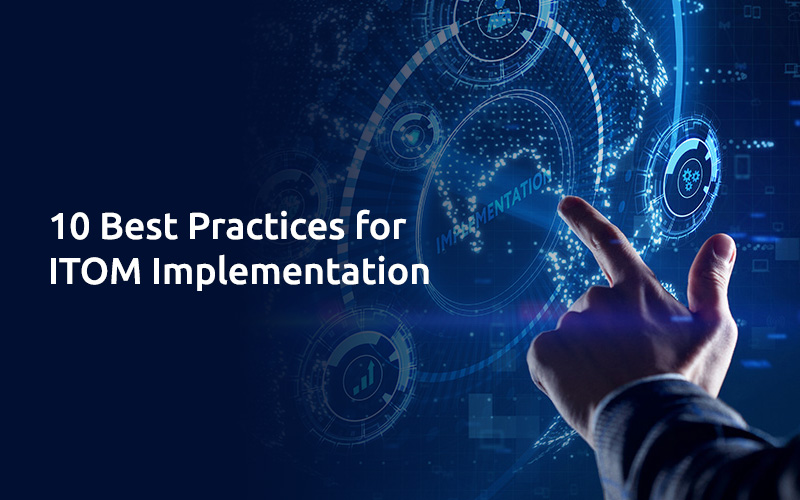
10 Best Practices for ITOM Implementation
IT Operations Management (ITOM):
The term ITOM, or "IT Operations Management," is used to refer to all processes involved in setting up, designing, configuring, deploying, and maintaining the infrastructure that underpins business services in an organization. ITOM, to put it another way, is the way your company manages its IT environment.
IT Operations Management is what keeps your IT running, covering everything from network security, configuration, and monitoring to devices, applications, and staff. To manage each of these activities independently, ITOM typically uses a variety of tools.
By increasing stakeholder visibility and control over an organization's data, investments, projects, and workforce, ServiceNow ITOM is a comprehensive solution to contemporary technology challenges like integrating disjointed IT processes, swiftly resolving service outages, and simplifying cloud complexities.
ITOM Best Practices:
Let us look at some of the best practices that will help drive ITOM Implementation success for you:
-
Aligning the Leadership with the Goals:
A significant, ongoing resource commitment is necessary for ITOM success. The pursuit of that commitment can be made easier with executive buy-in and support. Additionally, executive support can assist in navigating cultural shifts and reducing or overcoming any resistance that arises.
-
Knowing Your Current Operation Management Processes:
You must understand what these processes are, how they relate to your IT environment and business objectives, and how to manage and optimize them effectively. You need reliable solutions for discovering and mapping your IT landscape, as well as a solid understanding of IT operational processes. Your ITOM objectives might assist in justifying the purchase of any of these if your company doesn't already have any of them.
Your discovery may start with a manual audit of your environment and processes, depending on the size and complexity of your IT landscape, the scope of the existing processes, and the management resources at your disposal.
-
Define and Prioritize Goals:
Having a project plan is crucial for any IT project to succeed. In order to achieve your desired goals, it helps to give yourself direction and a step-by-step plan of action. These objectives may include acquiring new applications or services or reducing operational costs in the context of IT operations.
-
Choosing your Deployment Method:
You might also need to think about different deployment paths if you select multiple management techniques. Alternative strategies include hiring consultants and a dedicated management team. Additionally, you must carefully assess your potential approaches. If external expertise is required, you must pay closer attention to the relevant experience and have more open communication about costs.
-
Align Business Goal:
Make sure your ITOM plan is in line with your company's IT goals and initiatives for digital transformation. Additionally, make sure that all stakeholders' and important influencers' inputs are included in your ITOM plans.
-
Run a Data Audit:
The best information available must be the foundation for operational IT process decisions. Make sure your current data is accurate, complete, consistent, up to date, and able to communicate with your chosen ITOM solution before going too far down any specific ITOM solution path.
-
Automate:
All the routine and repetitive IT management tasks that are easily automatable should be listed. Then use rules based on business policies to automate those tasks. Automation guarantees that the work is done consistently. Additionally, it gets rid of mistakes made by people and frees up skilled workers to work on more difficult and complex tasks.
-
Integrating IT Solutions:
Integrate ITOM with the other IT management tasks, primarily ITSM and ITAM but not exclusively. The investment in ITOM and IT management integration efforts may be justified if your company isn't using a configuration management database (CMDB) to consolidate its IT management data.
-
Team Empowerment:
Ensure that everyone who is directly involved in ITOM efforts at your company receives thorough initial training in the solutions and procedures you have chosen, as well as regular follow-up training. Create an inclusive culture of ITOM awareness throughout your business by maintaining regular communication with them and your other important business stakeholders.
-
Choosing your Partners carefully:
To deliver long-lasting business solutions, your ITOM commitments must be both high-level and long-term. Equally dedicated to the success of your business must be the solution and service providers you select. You must make sure that these service providers are capable of upholding their commitments to your company both now and in the future.
DxSherpa Technologies is a high-growth, global IT services company with headquarters in the US and India. As a 100% ServiceNow-exclusive Premier partner, we serve medium to large enterprises across Asia, Europe, North and South America. Our expertise spans many industries with special emphasis in Manufacturing, Banking, Insurance, IT, and Healthcare. We have built a dedicated and focused team of 300+ consultants to serve our expanding client base across multiple disciplines on the ServiceNow platform. We believe in building trust and work satisfaction among our employees, customers and Partners by continuously enhancing our skills to deliver excellence.
